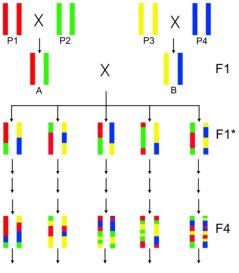
Project
Genetical genomics analysis of seed quality: adding a time component to omics QTL analysis
The yield and economic success of horticultural crops depends to a large degree on the quality of the seeds used to grow these crops. Seed quality attributes include dormancy, germination, seed and seedling vigour. We are using an integrated approach to survey these processes and resolve the underlying regulatory genes and signaling pathways.
Description
The yield and economic success of horticultural crops depends to a large degree on the quality of the seeds used to grow these crops. Seed quality attributes include dormancy, germination, seed and seedling vigour. We are using an integrated approach to survey these processes and resolve the underlying regulatory genes and signaling pathways.
In our project we combined two approaches to elucidate these pathways. First, we used the power of natural variation captured in a Recombinant Inbred Line (RIL) population to map Quantitative Trait Loci (QTL) for phenotype, metabolite and gene expression variation. Second, we performed both the metabolite and gene expression QTL analysis on 4 different developmental seed stages. This combined approach is called Generalized Genetical Genomics and provides a new way for studying the time- or developmental-specific flux of metabolites and genes that show genetic variation.
In this approach we first did an extensive phenotyping of a Bay-0 x Sha RIL population of 164 lines for around 100 phenotypes related to seed size, germination and seedling establishment. Subsequently the 164 lines of our RIL population were divided in 4 groups with similar allele distributions across the genome and seeds from each group were collected at a specific developmental stage. This resulted in samples of 41 lines each of dry fresh seeds, dry after-ripened seeds, seeds at 6 hrs imbibition and seeds at radicle protrusion. Primary metabolomes and transcriptomes were analysed in all these samples. We have started to analyse this huge dataset (100 phenotypes, 170 metabolites and 30.000 genes; all measured in 164 RIL lines), but more advanced data integration is necessary to exploit this dataset to its full potential.

Aim of the MSc project
During the MSc thesis you will be involved in developing more advanced network modeling strategies in which we can combine co-expression analysis with genetic mapping to maximize the information that can be extracted from such a huge dataset with an emphasis on integration of the different types of data.
Key words:
Seed quality, Generalized Genetical Genomics, network modeling strategies.